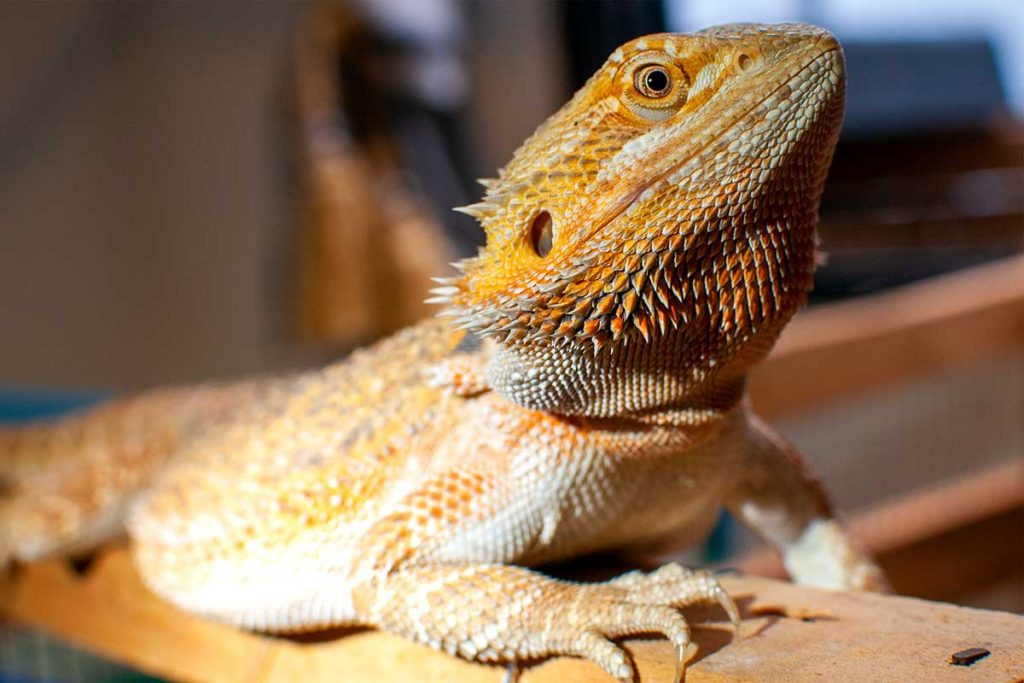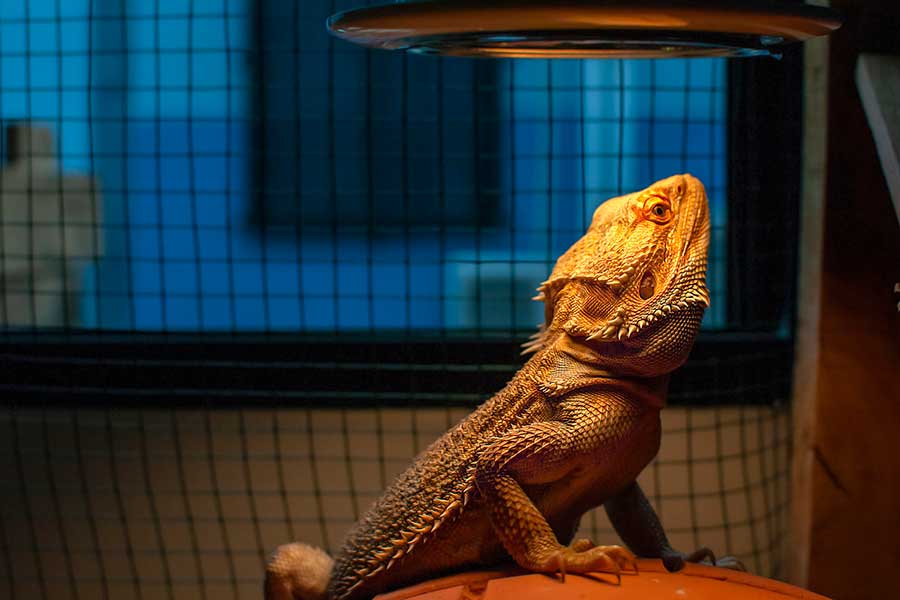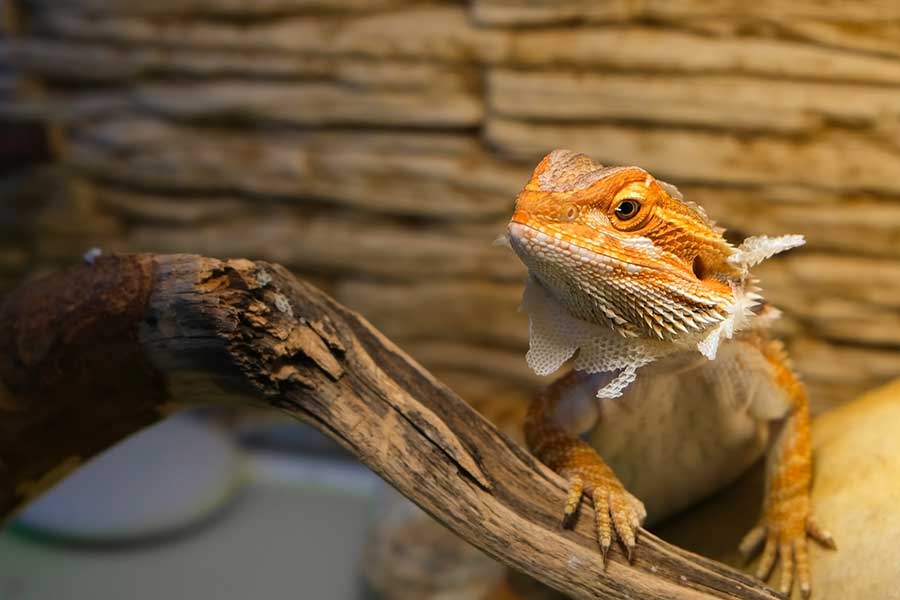Bearded dragons display some very odd behaviors, and it takes a while to decode everything they do so you can tell when they need something, something is bothering them, or they are just being oddballs. A common question many pet owners ask is: why is my bearded dragon hiding?
There are several reasons why bearded dragons hide in their enclosures. Some are easy to figure out and solve fairly quickly, while others can take some time to rectify.
Not to worry, though–this article will help you identify what is causing your bearded dragon to hide and provide you with some tips to bring them out into the open!
Sometimes, when you first bring home your bearded dragon, they will hide for days on end and stress you out. Fortunately, this is an easy fix; you just need to wait for them to become comfortable with their new home.
However, sometimes your bearded dragon may be hiding because they are scared of something or stressed out by something in or around their enclosure. In this case, it can take a fair amount of effort to figure out what is bothering them so much.
Read on to decode your bearded dragon’s odd behavior.
Reasons Why Your Bearded Dragon Is Hiding
1. Your Bearded Dragon Is Too Hot or Cold
Bearded dragons are ectothermic reptiles. This means they rely on external sources of heat to control their own body temperature, which in turn controls their metabolism. They need a warm side of the enclosure and a cool side to move between to be at the correct body temperature at all times.
Your bearded dragon’s enclosure temperature may be set incorrectly. If this is the case, your bearded dragon does not have an environment that allows them to move from hot to cold comfortably, and they may simply be hiding in a spot that provides them with the most beneficial temperature.
Ideally, your bearded dragon’s enclosure should sit between 75°F on the cool end and 85°F on the warm end with a basking spot of 90°F. The enclosure should never drop below 70°F at night with all of the lights off.
If your bearded dragon is too hot, then they will most likely hide somewhere in the cooler side of the enclosure, possibly in a hide or behind the decor.
However, if your bearded dragon is too cold, then they will probably be in one of their hides, behind foliage, or behind their basking platform on what should be the warmer side of their enclosure.
What Can You Do to Fix This?
Triple check your heating elements are working correctly. These could be a basking lamp, an under-tank heating mat, or a ceramic heat emitter. If you are worried that they are not heating or remaining at the correct temperature, you can connect them to a thermostat to control them.
To monitor the temperature in the enclosure, you should have digital thermometers on the cool and warm ends of the tank to determine whether the correct temperature gradient is being maintained.
2. Your Bearded Dragon Needs Some Dark Time
Bearded dragons are diurnal reptiles, so they are active during the day and sleep at night. They need a significant light difference between day and night in order to feel settled and to be able to sleep properly.
Your bearded dragon should have a 12-hour light and 12-hour dark photocycle. During the light portion of their photocycle, they should have access to either natural sunlight or light from a UV bulb to ensure they can process the vitamin D in their diets.
During the dark portion of their photocycle, they should have absolutely no lights on in their enclosure, and any other lights in the room should be off, too. The photocycle should be a routine, consistent occurrence and should not be random.
If your beardie cannot get complete darkness in their enclosure for at least 12 hours a day, then they will start to hide away during odd hours in the darkness of their hides or underneath the decorations in the enclosure.
What Can You Do to Fix This?
To stop your bearded dragon from hiding away during the day, ensure that all lights are turned off at night. They should not have any lights, even heat lamps, on at night. Ensure that no light from the surrounding room gets into their enclosure, either.
If the enclosure temperature drops too much at night (below 70°F), then you will need to install a non-light heat source, such as an under-tank heat mat or a ceramic heat emitter.
If you are not around at the same time every day in the mornings and evenings to turn their lights on and off, consider installing a timing device to control the lights to make sure their photocycle is routine and scheduled.
3. Your Bearded Dragon Is New to the Enclosure
When too many new things happen at once and you feel overwhelmed, don’t you want to hide away in some place that is dark and quiet until you adjust? Well, bearded dragons are the same.
When they are first introduced to their enclosure, everything is very overwhelming. They have new surroundings, many new smells may bombard their senses, there’s a strange human staring at them all the time, there are so many new sounds, and they just want to hide away.
Thankfully, this is fairly normal behavior for newly adopted bearded dragons whether they are adults or babies, so there is no need to worry too much.
What Can You Do to Fix This?
To help soothe your new bearded dragon while they adapt to their new home, you can do several things:
- Reduce the number of unnecessary decorations in the enclosure to reduce clutter and visual stimuli.
- Ensure there is a hide on the cool end of the enclosure and one on the warm end.
- Make sure there are rocks, logs, or foliage in the enclosure in such a way that allows your bearded dragon to get from one hide to the other without being seen.
- Reduce the amount of foot traffic that goes past your bearded dragon’s enclosure during their waking hours.
- Sit next to their enclosure at least once a day and talk to them in calm tones for 10 to 20 minutes at a time. This helps them get used to your voice, smell, and how you look in a non-threatening way.
Then just wait.
Your bearded dragon will take some time to get used to their new home.
4. Your Bearded Dragon Does Not Like the Decor
You may have added something new to your bearded dragon’s enclosure, such as a new toy, a new basking platform, some new foliage, a bed, or even a new, different kind of substrate.
Any kind of sudden change to their enclosure can cause a positive or negative reaction from your bearded dragon. If they love the new item, then great! However, if they are unsettled by it, they could hide away in a corner of their enclosure or in one of their hides to get away from it.
A new substrate may come with a new smell even if it is the same kind of substrate you’ve been using, such as coconut coir. If it comes from a different vendor, it could have a different scent and therefore unsettle your bearded dragon.
If you have added a toy, new bed, or climbing structure that has a bright color on it, such as red or yellow, your bearded dragon may be startled and apprehensive of the change.
What Can You Do to Fix This?
If you notice the hiding behavior right after you have made a change to their enclosure, even if you have just reorganized things after a clean, then change them back to the way they were or remove the new item.
Watch your bearded dragon carefully for any kind of change in their behavior, whether they continue to hide or they stop and carry on as they normally would. Then, you will be able to tell whether the change to their enclosure decor was what caused the hiding behavior.
If they continue hiding after you have removed the decor or changed things back, then look out for another reason they may be hiding that simply coincided with the new addition to the enclosure.
5. Your Bearded Dragon Is Brumating
Brumation is a perfectly natural behavior. It is kind of like a reptile version of hibernation. When the seasons change and get colder, reptiles go into a period where their metabolism slows significantly so they only need a little bit of external heat and little to no food at all.
For a more detailed look at what brumation is, check out our dedicated article.
If your bearded dragon began hiding when things got a little chilly outside, then it is a good possibility they are brumating. Check to see what months of the year your area will experience the biggest drops in temperature. These will be the times your bearded dragon starts hiding away to prepare for brumation.
What Can You Do to Fix This?
You do not need to ‘fix’ a brumating reptile. However, you can help them avoid brumation altogether by slightly increasing their overall enclosure temperature during the colder times of the year.
By doing this, your bearded dragon will not be able to feel the change outside and will not feel the need to start brumating.
However, if you wish to allow your bearded dragon to brumate, then you do not need to do anything. Check on them every day to make sure they are not losing too much weight and they are warm enough.
Once winter ends, they will naturally come out of brumation and stop hiding. However, you need to be sure they are hiding because they are brumating; otherwise, leaving them alone for weeks at a time without addressing a possible health concern can lead to serious injury or death.
6. Your Bearded Dragon Is Shedding
Shedding is one of the most common reasons your bearded dragon will start hiding out. Shedding is a completely natural process where the old skin sheds off the body and a new layer of skin is revealed underneath.
This is an itchy and often irritating time for your bearded dragon. They may be hiding away from you and the world because they are simply fed up with life and are waiting for their shed to end.
The problem with this is that they need to rub against things in their enclosure like rocks and logs to help the old shedding skin come off properly and in large pieces. So, hiding prolongs the shedding process.
Check out our dedicated guide on how often bearded dragons shed to give you a better understanding of the process.
What Can You Do to Fix This?
There is no ‘fixing’ shedding. However, you can do things to ease the process along and prevent your bearded dragon from hiding during this time.
When your bearded dragon is starting to shed, its skin will look very dull, and its eyes will look cloudy. Then its skin will start to peel off in random patches.
When you notice they are starting to shed, you can give them a soak once a day to encourage the shedding process and ease their irritated skin.
Get their bathing bucket ready with some clean warm water that comes up to your beardie’s elbows, throw in a toy or two, and place them in the water to soak and swim around. Make sure they can comfortably stand up with their heads out of the water, and never leave them unattended.
After about 10 to 20 minutes of soaking and swimming, take them out of the water and dry them off with a clean towel. Once they are patted dry, place them directly onto their basking spot in their enclosure to warm up.
This should speed up the shedding process and ease the itchy, grumpy feeling that is causing them to hide.
7. Your Bearded Dragon Is Stressed Out
I don’t know about you, but when I am stressed out, all I want to do is climb into bed and hide from the world! Bearded dragons can experience stress just like humans. Your beardie may have had enough of everything going on and want to hide away for a bit.
Stress is a normal experience; however, excessive stress is detrimental to your bearded dragon’s health. If you think your bearded dragon is hiding because it is stressed, look out for some other stressful behaviors to confirm your theory.
Arm waving, glass surfing, gaping, head bobbing and stomping, stress marks, and not eating are all signs your bearded dragon is stressed.
What Can You Do to Fix This?
Reducing stress is key to keeping your bearded dragon healthy and, of course, stopping them from hiding away.
To reduce stress, look out for and either fix or limit these things:
- Excess noise around their enclosure
- Incorrect temperature settings
- Incorrect photocycle
- Incorrect diet
- They are ill
- There are too many bearded dragons in the same enclosure
- Too much movement around the enclosure
- Your bearded dragon can see its natural predators (cats, birds, dogs) out a window
- Too much handling
8. Your Bearded Dragon Is Impacted
Impaction is a blockage of the digestive tract, and it is a fairly common health issue in reptiles like bearded dragons. If your bearded dragon is impacted, they will be in a great deal of pain or discomfort and will not want to move around a lot. They may even be so impacted that they are stuck in a particular place in their enclosure.
Impaction is caused by swallowing things that are too large to pass through the digestive system, such as food items that are too large, inappropriate toys, enclosure decor items, or pieces of substrate.
What Can You Do to Fix This?
To prevent impaction, you should always make sure:
- Your bearded dragon’s food is cut into pieces no larger than the space between their eyes.
- They do not have anything in their enclosure that is small enough to swallow but large enough to cause a blockage.
- Their substrate is not small enough to get into their mouths and accidentally be swallowed.
- They have plenty of dietary fiber in their diet, such as arugula and collard greens, to help clear out all the food in their intestines.
At the Tail End of Things…
There are many reasons why your bearded dragon may be hiding. Their behavior can easily be explained away if you know what to look for. Bearded dragons usually hide away when there is something in their enclosure they do not like or they are feeling icky and vulnerable due to stress or illness.
It is up to you as their owner to figure out why they are hiding away and see what you can do to encourage them to move around their enclosure more. Staying hidden means they do not get the right amount of exercise, enough UV light, or nutrition.
Be your bearded dragon’s hero and decode their behavior!




